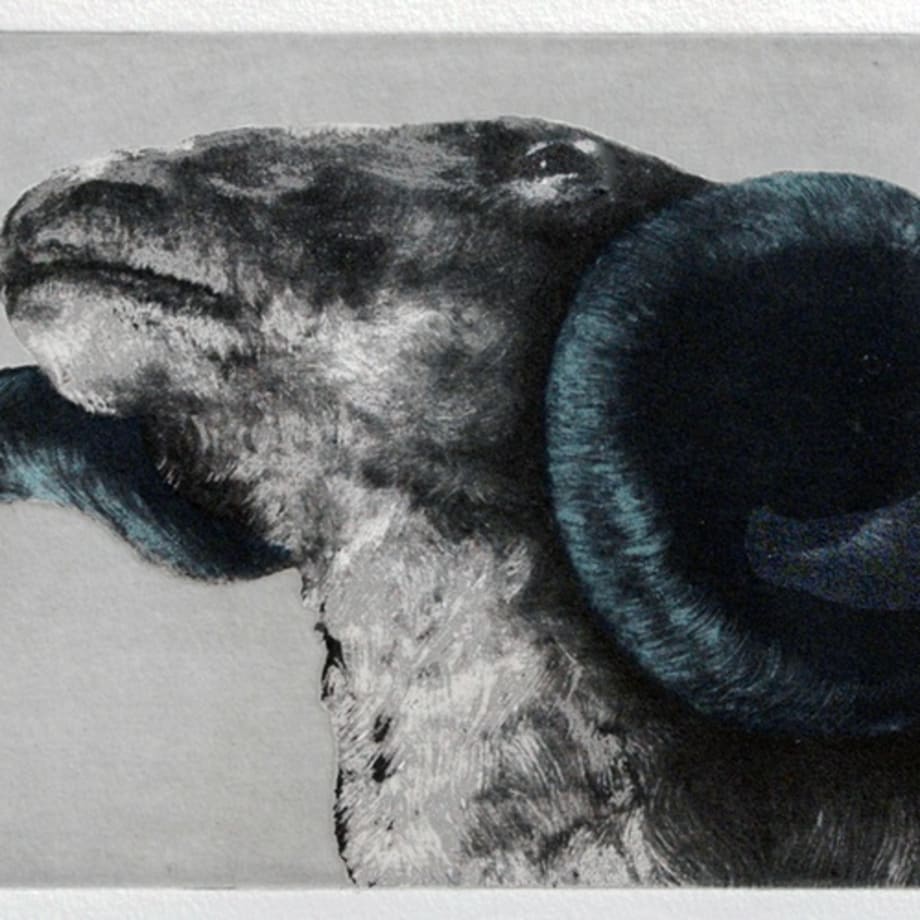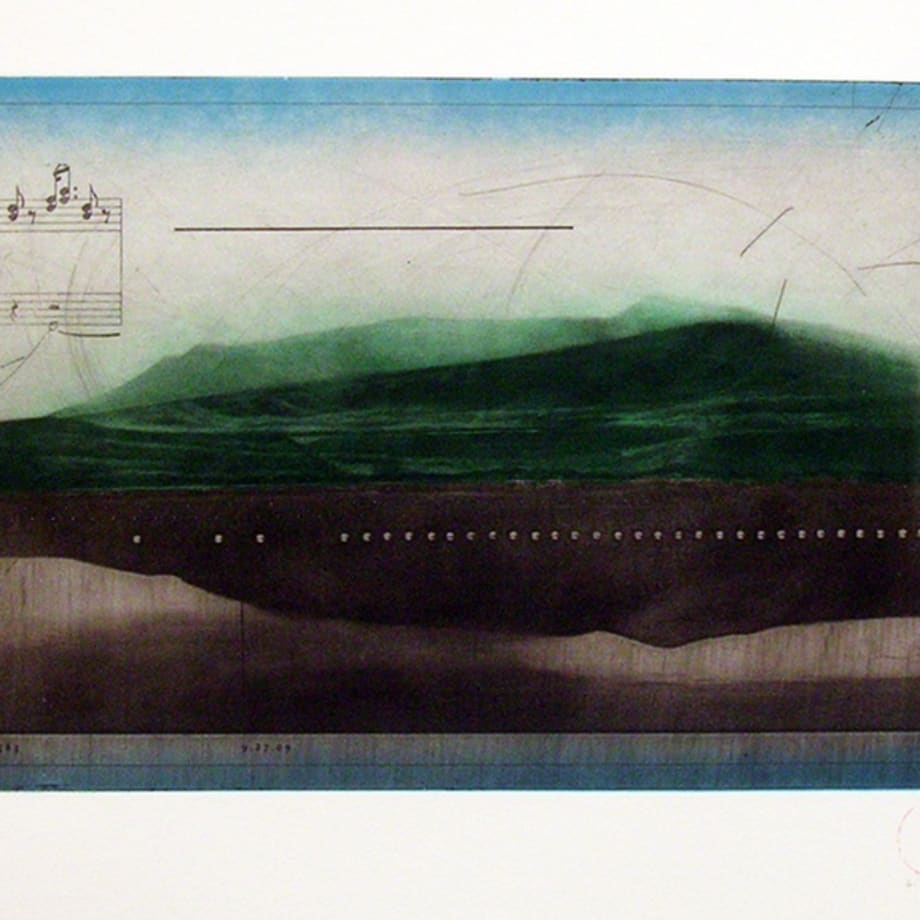PULL Print Portfolio: Kim Anno, Kate Javens, Joanne Mattera, Timothy McDowell, Don Pollack, Katherine Taylor
INTAGLIO PRINTS, ON RIVES BFK 19” X 26”
6 prints each, edition of 30
Marcia Wood Gallery, Publisher
Produced at Connecticut College, New London
The week of June 20 –26, 2010, six artists represented by the Atlanta-based Marcia Wood Gallery, plus Marcia, Ellen Barnard, and assistants, converged in the print studios of Connecticut College in New Londonto create a limited edition portfolio of intaglio prints, with the critical guidance of Master Printer, Timothy McDowell. The artists, Kim Anno, Kate Javens, Joanne Mattera, Timothy McDowell, Don Pollack, and Katherine Taylor live and work all over the United States. Ellen Barnard, owner of Tomorrow Pictures in Atlanta, produced a CD of the week’s events, with the camera assistance of Lucas McDowell.
The print portfolio project, ultimately titled PULL, was every bit the profound experience I had hoped it would be. The integrity, enthusiasm and talent of each of the artists, who are painters, resulted in a collaborative week of stretching, sharing, learning, and intense camaraderie.
The prints are stunning and deeply satisfying. Credit for helping the artists speak so eloquently in the language of ink goes to Tim McDowell and his mastery of printmaking. The artists came armed with wonderful ideas and deep experience and skill, and together with Tim created prints of exquisite depth and presence.
Each print is a whole of the sum of the essential parts of each artist's oeuvre, as well as a unique addition to their bodies of work. In the same mode, the six individual prints in each portfolio are a part of the whole, while they also stand alone in and of themselves. I think of this reciprocity as a metaphor for PULL as a project. Each artist working separately on their individual images pulling together to help produce each member’s edition.
--Marcia Wood
-

-

Kate Javens
"Father Ram"
I’d never made prints, or worked collaboratively on an art project before, so I wanted to be sure I came with an image that I was really excited about conceptually. I also wanted to work on one that would benefit from the other artists’ input, all of whose sensibilities I deeply respected. I made the Father Ram series to honor my father, but more broadly, to acknowledge the strength of youth and the boundries of that power. I love Frank O’Hara’s, The Hunter, for its rich examination of this concept. I drew the ram from below, looking straight up at its throat, and I was satisfied with its form. It needed to be defiant in its posture, almost heroic. Its vulnerability was going to be seen in its color. I went back and forth with this - Kim (who kept me from going overboard), Joanne and the other artists were a great help. Tim isolated the horn and ensured its sound color placement. I’m thrilled with the edition. Marcia was very perceptive in the selection of this group; we had the perfect mixture of inspiration, commitment, collaboration, and sweat. PULL rocked -

Joanne Mattera
"Soie"
I work mostly in encaustic, which brings luminosity and optical richness to the small color fields I paint. I’ve been working in this medium for 20 years, recently on a textile-inflected series called Silk Road, so I know what pigmented wax is capable of. And more to the point, I know how to make it do what I want it to do.
My challenge for the Pull project was to translate into ink what I know about luminosity, materiality and chromatic richness. Color was the easy part: Using two plates, I printed a scrim of transparent blue-green ink over a more opaque ground of yellow-green, so the emerald color you see is actually created in your own retina as you peer through the top hue into the one below it. But how could I make a medium that is designed to sink into the fibers of the paper do what paint does, which is to sit as a film on top? Knowing little about printmaking, I came up with intaglio plates whose ridges were so deeply incised that, in fact, I ended up with something of the tangible surface I’m used to. Beginner’s luck! As in my paintings, one layer of color is skewed at 90 degrees to the one beneath it—a grid with the suggestion of woven fabric. I called the print Soie, silk, to acknowledge this connection. The rotation of plates did not stop there. At the suggestion of our master printer, Tim McDowell, I turned my square plates 45 degrees to print them as a diamond. Because everything we do as artists is connected, the print that came from my square plates has spawnedDiamond Life, a new series of paintings oriented on the same axis. -

TIMOTHY McDOWELL
"Arcadian Troubles"
No medium prior to the invention of the Internet has done more to bring image and text to millions of people. The sharing of images, the influencing of culture and audiences worldwide was also accomplished by the print a thousand years ago. The various techniques incorporated for durability, capable of satisfying the visual demands of artists and publishers, brought to the art world a new language and a new range of beauty to the mark and the rendering of image. Each of the traditional forms of printmaking provides the artist with unique qualities in defining the line, value and form of image. I make prints because they are prints. No other medium can provide the visual vocabulary uniquely inherent with that of an etching; it is its own genre. The characteristics of the idiom are the reason to explore it.Each hand pulled print may be part of an edition of impressions made from the plate or plates used to hold the ink; but each print is also a unique work of art with subtle differences and ever so slight variations revealed only under close scrutiny. Each hand made impression always gives me a thrill when lifted off the press bed. The process is always demanding but at that moment, oh so rewarding.
-

Don pollack
"Mysterious Island"
In order to explain my process, first I will give a little background information. The image I printed was inspired from the 8th edition of the "Museum In Trust" series,– an installation-painting project. This intaglio print shares the same name as the exhibition titled, "Mysterious Island" and considers the conjunction of image making and musical notation. Contemporary physics, anthropology, and linguistics demonstrate that we live in a participatory universe and the notion of people as casual observers is illusory. The very act of creating a landscape can soon find itself occupying the space it seeks to frame. The dilemma this paradox poses has revealed a relationship between the image and the methods used to record it. Musical notations, another aspect of creating a record or a document, was explored sympathetically with the images to speak of place.While working with musical notations, I came across some recent scientific studies that generated sound clips out of the data from the universe revealing music coming from our own solar system! Astrophysicists have also proven that the Earth moves to the rhythm of the Sun and this year the European Space Agency announced that the “Earth’s magnetic field, atmosphere, and even voltages induced on ocean cables, are all taking part in a cosmic sing-along.”
Now my next challenge was how to translate all of this into a new medium for me,– printmaking. At first I first tried exposing a print plate from my initial image rendering but it was accidently reversed revealing a positive view. This ended up not being a loss however, because looking at the image on the plate, I was immediately reminded of the Japanese print styles of the Ukiyo-E or the 'floating world'. This floating world was a place that would vanish in the mist. I thought it would be a great starting place to try and capture the mysterious nature of my island landscape.
As my work at times references history and documents, Tim McDowell, our master printer, suggested a slight drop of color wash on the top as well as the bottom of the print. This nod to a time honored approach in printmaking images of the landscape was a great suggestion and it also reminded me of the subtlety of a hand colored photo. Tim inked and wiped down two printing plates with slight washes of color in a very tedious process that ultimately rendered a 4 color image! Needless to say, his knowledge and expertise of the print process was phenomenal.
This intensive week was an amazing experience for a couple of reasons. Diverse people and artists with diverse backgrounds came together at Connecticut College to produce an amazing suite of prints but also, a great connection was made and a wonderful sharing occurred. The result of the "Pull" portfolio project was a unique effort of teamwork that ended up producing a highlight of individual talents.
-

katherine taylor
"Parallax"
Making ‘Parallax’ gave me the opportunity to work with color and image in a discipline very different than painting. I had worked with intaglio as an art student and was again excited at the potential to experiment with this form of printmaking. I have always considered the medium as tangential to components of how I conceive imagery. The collective project for “Pull” added another layer of importance to an already fraught process. As a result I refined my thinking and entered the project with a concept that satisfied my desire to experiment.
One foundational element of printmaking is its inception as a medium to disseminate language to the masses. The historical value of this technical process laid the groundwork for a contemporary popular culture shaped by visual language. Hand crafted postcards, nostalgic newspaper clippings and photographs are relics that signify this origin. ‘Parallax’ compresses this anecdotal evidence in the image of a flipped american car onto a palm treed landscape. The resulting print uses perspective, space and light to merge subject and object into single view, a two dimensional landscape where catastrophe is already inscribed.




















